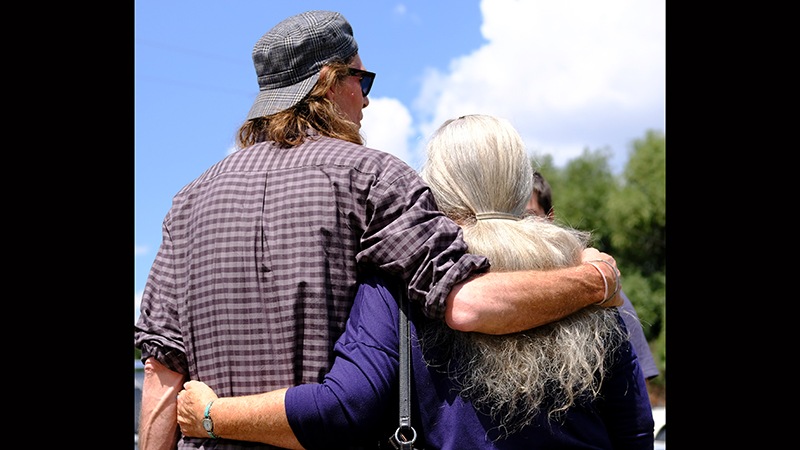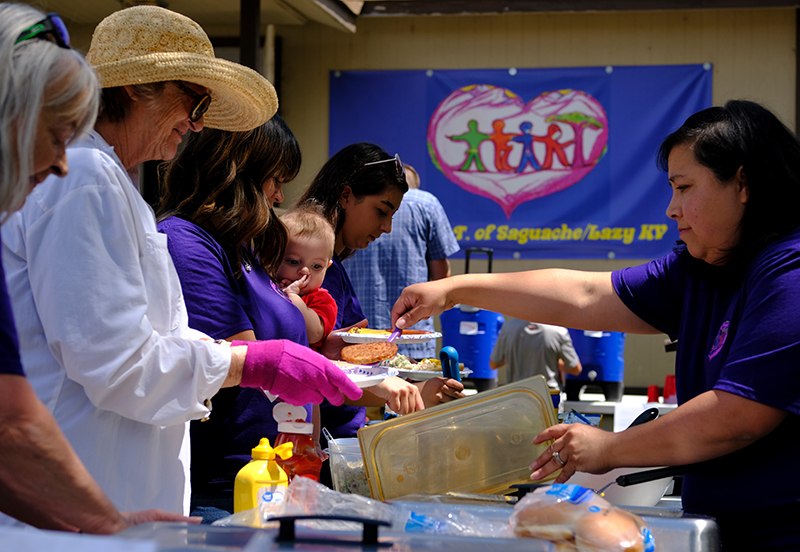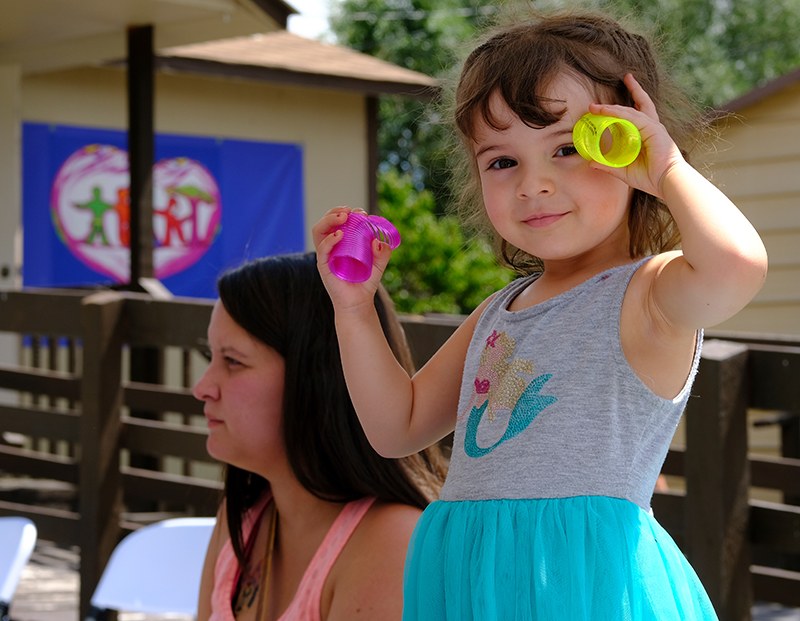How To Save a Life
Leer en español
The community of Saguache, Colo. gathered on Aug. 17 to celebrate the launch of a plan to improve the health of the town, even as unexpected deaths in the community gave them reason to mourn. Photos by Joe Mahoney
By Kristin Jones
Nearly everyone in the town of Saguache has been affected by a string of recent deaths in the community—including by suicide, accident and alleged murder.
On Aug. 23, people gathered on Main Street for a vigil to mourn those who died, and to draw closer.
“In a small community, we are family,” Laurie Vigil, who has lived in Saguache for four decades, said later. The population of this San Luis Valley town is less than 500, and Vigil can’t remember a time when so much bad happened so suddenly. “We joke that although sometimes we are dysfunctional, when there’s trouble or strife, we come together.”
This wasn’t the kind of gathering that Vigil had in mind when she and a group of fellow Saguache residents had the idea of getting together as a community more often. They call themselves the Saguache/Lazy KV Health Equity Action Resident Team, or HEART, and they are a diverse group—young, middle-aged and elders, white and Latino, newcomers and old-timers.
The residents have been meeting for the past couple of years to talk about the biggest barriers to good health here, with support from The Colorado Trust’s Community Partnerships initiative. The picturesque town is in a beautiful part of the valley, but it can be a hard place to live.
HEART team members interviewed their neighbors, sorted their problems into categories and asked themselves “Why?” over and over. Why were people sicker here than in other parts of the state? Why were people going hungry? Why did so many young people leave town the minute they had the chance?
At the root of it all, they found, was poverty, and a sense that the people most impacted by local decisions weren’t included in making them. Hispanic and low-income residents, especially, felt excluded.
HEART proposed a set of solutions, and announced them publicly with a barbeque on Aug. 17. It was supposed to be a happy event, but it was marred by heartbreaking news: A recent high school graduate’s suicide, another young person’s death in a fall, a young grandmother killed in a car crash. The terrible list went on. Vigil counted 15 deaths in a matter of a few months, and more since then.
But the plan, which goes into effect this fall, is important, said Vigil. The first part of it is intended to stimulate the economy and keep young people engaged and prosperous in the town they grew up in. The local high school has agreed to start a youth career pathway, geared particularly toward kids who might not be considering college. It begins with an entrepreneurship camp in October for interested students.
HEART has contracted with a Nebraskan named Craig Schroeder, whose specialty is breathing new life into rural America. He’s the director for youth engagement at the Center for Rural Entrepreneurship in Lincoln, Neb.
“Poverty and disengagement—that’s not an unusual challenge for rural communities,” he said. “As we look across this part of the country, there are a lot of towns that have lost population over the last 90 years, through out-migration to urban areas.”

The trend has had an impact on the mentality of the adults, Schroeder added. “We’ve developed a mindset that maybe we don’t have a future, maybe our best opportunities for young people are to leave and not come back. That message is sent to young people in different ways.”
That’s often at odds with what the young people themselves want.
“The research shows that young people love their communities,” said Schroeder. “They would like to be able to stay or come back because this is where they’re from, this is where their family is. This is their heritage.”
Stacey Amos Holden, an immigrant from Bermuda, has lived in Saguache since 2004, and was recruited by her daughter, a high schooler, to join HEART. She is hoping for—and working for—a transformation in the town.
“I have a child that I’d like to see come back here, or at least stay in the area,” Amos Holden said. “And I don’t think she would, if we don’t make things change now, to a place where she would want to raise a family.”
Kathy Hill, the principal of Mountain Valley School in Saguache, said that she fell in love with the town when she moved here 32 years ago. But jobs are limited, and it can be tough to find housing. Two of her staff members, she said, can’t afford to live here.
Hill said she wants to see the new youth-career pathway help connect young people with what jobs do exist in the community, and give them the skills to build their own businesses.
“As an educator, you look deep down and [ask], ‘what are the really vital things for our kids?’ It’s giving them a sense of ownership, that they have control of their lives to do whatever they want,” Hill said. “They can use their skills. They can create businesses. They can be creative and partner with others to do good things in our own community, and also to reach out and go other places.”
Education isn’t just about preparing students for college, Hill said. It’s about preparing them for life.
“If I retire and I see kids who went to our school open businesses on our Main Street, that would be great,” she added. “It would help our area so much.”
The other part of the plan is to invite more people into making the big decisions around here—decisions like what happens at the school, and what gets accomplished by the various planning committees, boards and local government agencies.
“It seemed like always the same people were stepping in and taking charge of things,” said Amos Holden. So they went out and asked their neighbors why they weren’t getting involved. “We found that they felt that they weren’t wanted.”
That’s where the idea for more community gatherings came from. The idea was to let people know that everyone was wanted.
HEART is also offering a 20-week training program from the Family Leadership Training Institute to members of the resident team and young adults in the town, in Spanish and English. In the first 10 weeks, they’ll learn about the leadership roles they already have in their families, and how to build on their own strengths. In the second half, they’ll learn how to engage with local organizations to advocate for their own interests.

The plan was never just about economic development, learning new skills and having barbeques, though. It was always about how people are healthier and happier if they know that they are valued, and are given the tools and opportunities to have power over their own lives.
The plan was always about saving lives.
Additional reporting by Lindsay Hahn of Chance Multimedia.